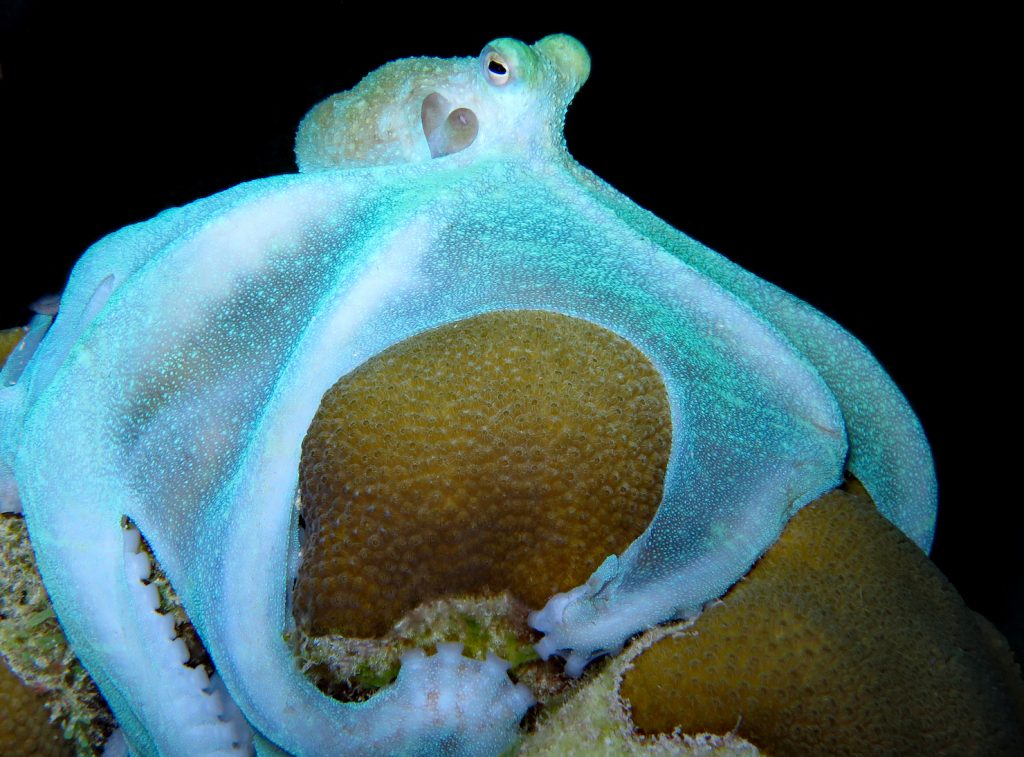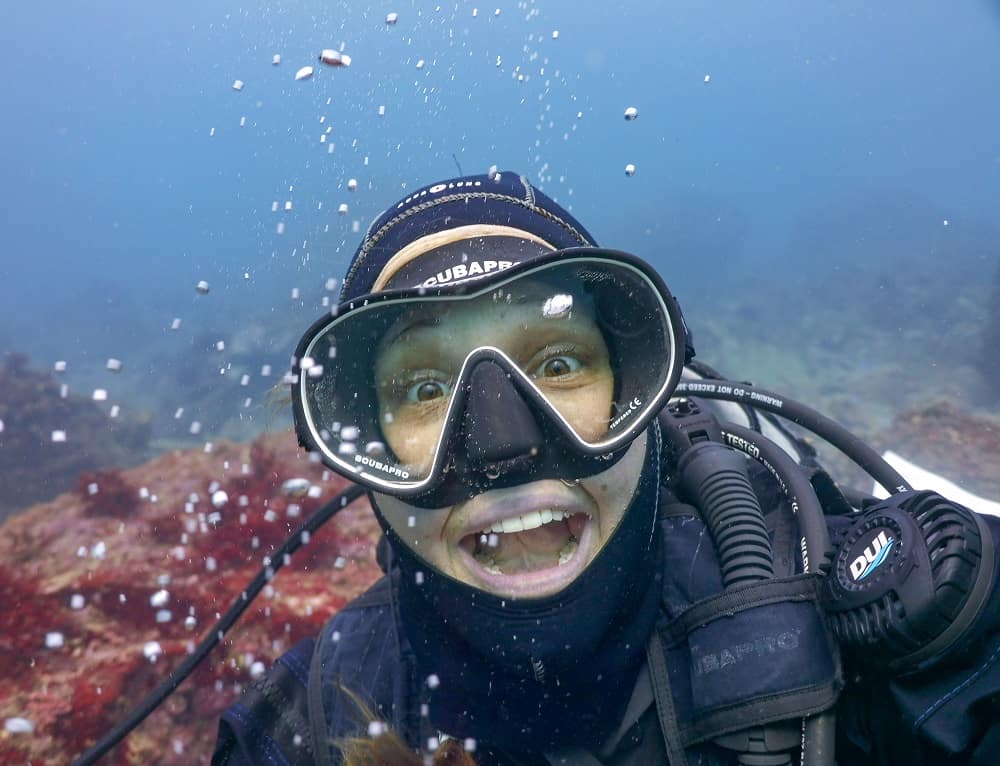7 Jaw-Dropping Caribbean Reef Octopus Facts
As the sun goes down and the reef descends into darkness, who comes out to play? The Caribbean Reef Octopus! This blue-green iridescent, shallow water octopus is one fancy cephalopod and a master of turning itself into a shimmery parachute to snare prey in the dead of night. Read up on all of these Caribbean Reef Octopus facts to really grasp how amazing this octopus species is!

The Caribbean Reef Octopus (Octopus briareus) is a big-eyed, mid-sized octopus who prefers shallow, coral reef habitats where they spend their days hiding in their dens, only emerging at night to forage for food.
As the name suggests, they do indeed live in the tropical waters of the Caribbean, but can also be found from south Florida to the northern South American coast.
Their vibrant skin changes are mesmerizing to watch as they change from a luminous orange to purple to a mottled brown to blue-green while gliding across the reef.
All thanks to the magic of chromatophores, iridophores, and leucophores working together to produce this masterful array of colors!

If points were awarded for the most colorful cephalopod, the Caribbean Reef Octopus would be right up there with the bedazzled Strawberry Squid, the fabulously caped Blanket Octopus, and the eye-catching Australian Cuttlefish!
Their skin-changing ability helps them effortlessly camouflage into their surroundings so predators, such as eels, stingrays, and sharks, will pass right by never knowing they missed out on a potential meal.
7 Fun Facts About The Caribbean Reef Octopus!
With so many of you asking us questions about this dazzling octopus species on our Facebook and Instagram posts, we wanted to share some more fun facts about the Caribbean Reef Octopus.
They make themselves into a parachute to catch food
To trap their meals, some octopus species can extend their arm webbing like a parachute!
Depending on the species, octopuses can either have:
- A shallow web (barely reaching down their arms)
- A deep web (extending almost fully down the arms known as interbranchial webbing)
For the Caribbean Reef Octopus, their webbing runs DEEEP!
This octopus hunts by throwing its arms over large pieces of coral while extending its webbing to form a tight cling wrap seal. Knowing nothing can escape from under their parachute-like body, they comb through the coral with the tips of their arms, poking, and prodding until they find a snack.

Once they have chased a tasty crab, lobster, fish, or worm out from their hiding spot and into their dinner chute, hundreds of powerful suckers will work together as a conveyor belt tasting and moving the food to their mouth.
They use their beaks and radula to tear apart their prey while also using their salivary papilla (mouthpart acting as a tiny drill) to inject venom helping to paralyze their prey.
Tip: Want to know more about how octopuses eat? Check out our blog post!
This octopus species is a nocturnal ambush predator that moves from surface to surface, treating the reef as its all-octo-can-eat buffet before retreating to its den to snooze the day away.
You’ll often be able to spot an octopus den as they’ll block the entrance with shells of dead clams and pieces of coral!
Who doesn’t LOVE a good lobster dinner?
A fancy feast for a fancy octopus!
A Caribbean Reef Octopus’s favorite meal is a Caribbean spiny lobster.
But guess what? Those spiny lobsters don’t love being eaten and they don’t have large claws like the Atlantic lobsters to defend themselves.
So how do they escape those strong, flexible octopus arms equipped with hundreds of suckers?
They create a sound to throw off a hungry octopus combined with a few quick tail flips and they make their escape. The rasping or buzzing sound they make is called stridulation and comes from a specialized organ at the base of their long 2nd antennae.
A study showed that when a lobster would stridulate upon being caught by an octopus, they escaped every time. When compared with lobsters who were silent, the octopus caught and ate them 40% of the time.
Apparently, octopuses don’t like their food when it’s buzzing at them!
Oh boy- are they smart!
At this point, there is no doubt that octopuses are the smartest invertebrates in the ocean.
The Caribbean Reef Octopus uses its brainiac side to learn from its experiences and become the master of its domain.
While this stealthy species forages across the reef, it learns where all the good food spots are located. It will return to places of high prey density to hunt, showing that this octopus processes information, forms memories, and has analyzed that information for its benefit!
Kind of like having the best taco of your life and committing the location to memory so you know exactly where to return whenever that taco craving strikes.
(IYKYK 😉)

Honestly…not the friendliest neighbors
In general, octopuses tend to live solitary lives and the Caribbean Reef octopus is no exception.
They live alone in their dens during the day, hunt by themselves at night, and only interact when it’s time to make octopus babies.
They like their alone time so much that they will go so far as to kill and eat another octopus that dares to disturb their den zen.

Aww, they grow up so fast!
Since they only have a short life span of around a year, the Caribbean Reef Octopus must come onto the scene with a ‘seize the day’ mentality.
That starts when they are ready to hatch!
Mama octopus lays 200-500 eggs, which take between 50-80 days to hatch.
A baby only takes 15 seconds to hatch out of their egg sac and enter the world ready to:
- Change color
- Use jet propulsion
- Squirt ink
No time to waste!
These Caribbean Reef Octopuses skip the planktonic stage and go straight to living on the reef. They increase their weight by about 5% per day, reaching their full adult size in about 5 months.
They are also ready to mate at this age… and so the cycle continues!

Keep. that. reef. HEALTHY.
Predators like this octopus are crucial to the functionality of coral reefs as they keep the number of grazing animals in check.
If octopuses are overfished and removed from the reef, the number of grazers increases, and the reef suffers.
When you look after the predators, you look after everything underneath.
Long story short, ecosystems need to keep that harmonious balance between predators and prey!
Say hi to Dreamy Dani!
Did you know the Caribbean Reef Octopus has its own portrait?
OctoNation’s Creative Director, Chris Adams, took the oh so beautiful Caribbean Reef Octopus and turned it into a whimsical artist rendering complete with an orange creamsicle and a flamingo pool floaty.
You can find Dreamy Dani on all sorts of things in our OctoNation shop!
Share All Of These Caribbean Reef Octopus Facts With Your Friends!
Now, when someone asks you about that cute octopus on your shirt, you’ll have lots of fun facts to share with them.
If you want to educate yourself some more about all sorts of different cephalopods, take a look at our encyclopedia. Or, what we call it, our Octopedia!
Connect with other octopus lovers via the OctoNation Facebook group, OctopusFanClub.com! Make sure to follow us on Facebook and Instagram to keep up to date with the conservation, education, and ongoing research of cephalopods.
More Posts To Read:
- Book Giveaway: “Secrets of the Octopus” & Bonus interview!
- ‘Artist Spotlight’ Of The Week: Victor Grasso
- Meet the Cockeyed Squid: the Deep-Sea Animal with a Giant Eye!
- ‘Cephalotography’ Of The Week: Jialing Cai
- 10 Facts About Baby Nautilus!

Corinne is a biologist with 10 years of experience in the fields of marine and wildlife biology. She has a Master’s degree in marine science from the University of Auckland and throughout her career has worked on multiple international marine conservation projects as an environmental consultant. She is an avid scuba diver, underwater photographer, and loves to share random facts about sea creatures with anyone who will listen. Based in Japan, Corinne currently works in medical research and scientific freelance writing!








